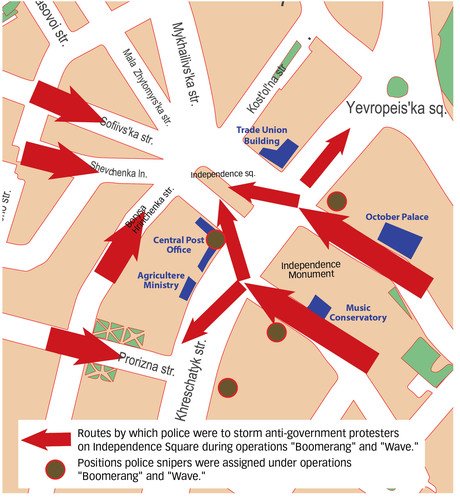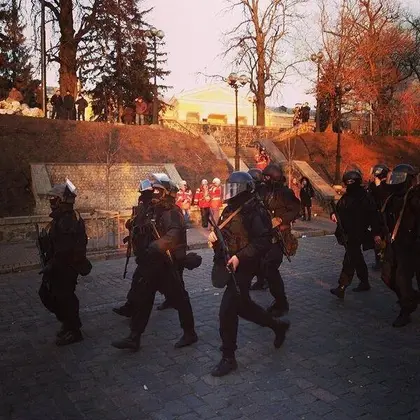Hennadii Moskal, a
member of parliament with Yulia Tymoshenko’s Batkivshchyna Party and Ukraine’s
former deputy interior minister, said the plan called for surrounding Kyiv’s
Independence Square with rooftop snipers whose mission would have been to wipe
out the anti-government EuroMaidan protesters. Moskal said he obtained
documents outlining the plan and released part of them publicly on his Facebook
page in order to ensure that law enforcement officers bring criminal charges
against Yanukovych and others responsible for the plan.
Whatever the aim of
Yanukovych and former Interior Minister Vitaliy Zakharchenko, whose whereabouts
is also unknown, at least part of the plan seems to have been implemented.
Snipers working behind police lines on the south side of Independence Square
killed at least 88 protesters from Feb. 18-20 before a temporary ceasefire took
hold. Yanukovych signed a compromise agreement with opposition leaders on Feb.
21, but then fled Kyiv on Feb. 22 after his security and law enforcement
officers abandoned him. Parliament impeached him the same day. An arrest
warrant charging him with mass murder was issued.
A joint statement by
Zakharchenko and then-acting SBU head Oleksandr Yakymenko said their agencies would
use “all legal measures” against protesters at 6 p.m. on Feb. 18 if
“lawlessness would persist” in central Kyiv.
The documents Moskal
said that he obtained identified the special operations by two code names –
Boomerang and Wave.
The plans called for
the deployment of 22,000 police officers, including 2,000 Berkut riot police,
and 224 Security Services of Ukraine anti-terrorist Alpha Group officers,
including seven snipers.

The documents also
show that the plans called for the use of armored vehicles, various grenades
and auxiliary units such as, bomb squads, emergency services, communication
personnel and traffic police.
Moskal told the Kyiv
Post the
documents accounted for only 10 percent of the operations’
entire plan and said he would disclose the rest if authorities do not
investigate and open criminal cases in the matter. He said he will cooperate
with investigations.
Moskal said he
published the materials to pressure the interim government into investigating
the alleged operation.
He also said that,
according to the documents, Russia played a role in the planned mass murders.
Moskal said that the
former first deputy head of the general staff of the Russian Armed Forces’ Main
Intelligence Directorate played a major role in planning the operations. Moskal
said the Russian’s advice was needed because former acting Security Services
head Oleksandr Yakymenko and Zakharchenko were not qualified to conduct such an
operation. Yakymenko was a pilot and Zakharchenko was an economic crimes unit
officer.
An e-mailed inquiry to
Russian President Vladimir Putin’s spokesperson Dmitri Peskov wasn’t immediately
answered. The Russian Embassy in Kyiv was unavailable for comment.
According to Moskal,
Zakharchenko gave the orders to shoot. On Feb. 20, Zakharchenko said publicly
that police were authorized to use firearms to defend themselves.
Also guilty of giving
orders, Moskal said, are” ex-Deputy Interior Minister Viktor Ratushniak, former
department head of public safety Oleksiy Krykun, ex-commander of the Interior
Ministry’s troops Stanislav Shulyak; chief of the main Interior Ministry
department in Kyiv Valeriy Mazan; ex-head of the Security Service of Ukraine
Oleksandr Yakymenko and his first deputy Volodymyr Totsky; Security
Services of Ukraine head for Kyiv and Kyiv Oblast Oleksandr Shchoholiev; and
SBU Alpha Group commanders.
They could not be
reached for comment. Many of their mobile phones, listed in the documents, are
turned off or out of service.
Many of the
operations’ plans coincide with the actual events that took place during the
police raid of Feb. 18-19.
The raid began at 8
p.m. on Feb. 18 and left 26 people dead, including 10 police officers and more
than 1,000 injured. At least 60 people died on Feb. 20, mostly from deadly
sniper fire. Three police officers died on the same day. In all, nearly 100
people (88 according to the Health Ministry’s latest count) have been killed in
EuroMaidan protests since January.
At least some of the
murderous plan outlined in the documents mirrors what happened.
For example,
operatives used the roof of an adjacent building to access the House of Trade
Unions, EuroMaidan’s then-headquarters on Kyiv’s Independence Square. Police
attacked the House of Trade Unions sometime after midnight on Feb. 19. During the chaos, the building
caught fire and burned throughout the night and into the morning.
The new perimeters
that security and police forces set up after their raid resemble one of the
proposed plan’s objectives.
The plan called for
electricity to be cut off as it was on Feb. 18. KyivEnergo, the electricity
utility owned by billionare Rinat Akhmetov – a major backer of Yanukovych –
would have been responsible for electricity to the building.
Channel 5 – a TV
channel that was critical of the authorities and is owned by lawmaker Petro
Poroshenko – was actually cut off as per the plan.
Also, plans called for
the metro entrances and exits of Maidan Nezalezhnosti and Khreshchatyk to be
shut, as they were.
Road access to the
center was to be tightly controlled or blocked, as it was on Feb. 18-20, with
people spotted traffic police armed with Kalashnikov rifles.
Also, an armored
vehicle was used to storm the barricade as per the police plan, but protesters
set the vehicle ablaze with numerous Molotov cocktails.
The plan listed the
names and mobile phone numbers of the state security and police officers that
were responsible for each of the 24 disclosed assignments.
Only one person was
reachable: Volodymyr Kotov, an explosives specialist. He told the Kyiv Post
that his service didn’t take part “because there was no sign of explosives in
the city center and no order for his group to take part in the operation.”
He said that Boomerang
is a common term that police and the secret services use for anti-terrorist
operations, adding that he was not aware of operation Wave.
Another event that
adds legitimacy to Moskal’s claims and the documents’ authenticity is the use
of snipers. In the operations’ plans, seven Security Service of Ukraine Alpha
Group snipers were to be used and stationed atop four buildings on
Khreshchatyk.
On Feb. 20, sniper
fire killed dozens of protesters from positions along Institutska Street that runs
perpendicular to Khreshchatyk Street. The most senior sniper listed was
Lieutenant-Colonel A. M. Bychkivsky whose code name listed is “Myron.”
According to audio
recordings made public on YouTube, allegedly of the radio communication of
snipers on Feb. 20, a person named “Myron” is heard coordinating his actions
with others.
This report was compiled by the
Kyiv Post staff. All of our contacts are at https://www.kyivpost.com/pages/contact-us.
You can also highlight the text and press Ctrl + Enter



